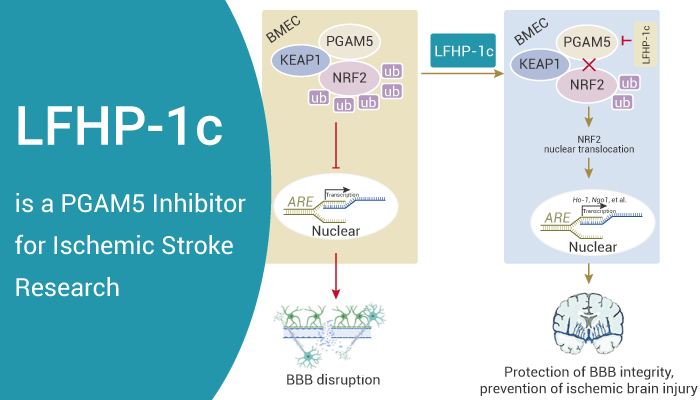PGAM5 (Phosphoglycerate Mutase Family Member 5) is a mitochondrial Ser/Thr phosphatase, usually located in the inner mitochondrial membrane (IMM). Specifically, it targets the phosphorylation of serine, threonine and histidine residues to exert dephosphorylation activity. PGAM5 cleavage activates WNT signaling in a parkin-dependent manner, thereby inducing mitochondrial biosynthesis. But also, it forms tertiary complexes with Kelch-like ECH-associated protein 1 (KEAP1) and Nrf2, which inhibit nuclear translocation of Nrf2. PGAM5 isolates Nrf2 in the cytoplasm, thereby preventing its activation. The AMPK-Nrf2 pathway is an important target in neurodegenerative diseases. Inhibition of PGAM5 can restore AMPK-Nrf2 pathway conduction. This has an improved effect on ischemic stroke diseases. Here we’ll introduce a PGAM5 inhibitor, LFHP-1c.

LFHP-1c exihibits anti-inflammatory and neuroprotective effects and also activates the AMPK-Nrf2 pathway.
Lfhp-1c-induced neuroinflammatory inhibition is related to AMPK-Nrf2 pathway activation. It inhibits PGAM5 phosphatase activity and the interaction between PGAM5 and Nrf2. In rat brain microvascular endothelial cells (rBMECs), LFHP-1c promotes PGAM5-inhibited Nrf2 nuclear translocation and increases NRF2 protein levels.
In animal models, LFHP-1c ameliorates neuroinflammation during ischemic stroke through 5′ –adenosine monophosphate activated protein kinase (AMPK) and Nrf2 activation. It reduces the volume of cerebral infarction and improves neurological deficits in a rat model of transient focal cerebral ischemia. LFHP-1c also altered M1/M2 polarization in mouse neuroinflammatory models. BBB destruction was prevented after transient occlusion of middle cerebral artery (tMCAO) in rats, and cerebral ischemic injury was improved in tMCAO model of fasciculate muscle.
In summary, LFHP-1c is a potent PGAM5 inhibitor capable of restoring AMPK-Nrf2 pathway, producing anti-inflammatory and neuroprotective effects.
References:
[1] Gao C, et al. Acta Pharm Sin B. 2021 Jul;11(7):1867-1884.
[2] Wang Y, et al. Antioxid Redox Signal. 2018 Jan 10;28(2):141-163.